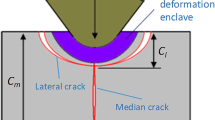Abstract
To intuitively reveal the surface formation mechanism in machining of SiCp/Al composites, in this paper the removal mode of reinforced particle and aluminum matrix, and their influence on surface formation mechanism were analyzed by single diamond grit cutting simulation and single diamond grit scratch experiment. Simulation and experiment results show that when the depth of cut is small, the scratched surface of the workpiece is relatively smooth; however, there are also irregular pits on the machined surface. When increasing the depth of cut, there are many obvious laminar structures on the scratched surface, and the surface appearance becomes coarser. When the cutting speed is small, the squeezing action of abrasive grit on SiC particles plays a dominant role in the extrusion of SiC particles. When increasing the cutting speed, SiC particles also occur broken or fractured; but the machined surface becomes smooth. When machining SiCp/Al composites, the SiC may happen in such removal ways, such as fracture, debonding, broken, sheared, pulled into and pulled out, etc. By means of reasonably developing micro cutting finite element simulation model of SiCp/Al composites could be used to analyze the surface formation process and particle removal way in different machining conditions.









Similar content being viewed by others
References
Jahedi, M., Ehsan, A.B., Knezevic, M.: Microstructure metrics for quantitative assessment of particle size and dispersion: application to metal-matrix composites. Powder Technol. 311, 226–238 (2017)
Bains, P.S., Sidhu, S.S., Payal, H.S.: Fabrication and machining of metal matrix composites: a review. Mater. Manuf. Process. 31(5), 553–573 (2015)
Rhee, H., Whittington, W.R., Oppedal, A.L., Sherif, A.R., King, R.L., Kim, H.J., Lee, C.: Mechanical properties of novel aluminum metal matrix metallic composites: application to overhead conductors. Mater. Des. 88, 16–21 (2015)
Bushlya, V., Lenrick, F., Gutnichenko, O., Petrusha, I., Osipov, O., Kristiansson, S., Stahl, J.E.: Performance and wear mechanisms of novel superhard diamond and boron nitride based tools in machining Al-SiCp metal matrix composite. Wear. 376–377, 152–164 (2017)
Du, J.G., Li, J.G., Yao, Y.X., Hao, Z.P.: Prediction of cutting forces in mill-grinding SiCp/Al composites. Mater. Manuf. Process. 29(3), 314–320 (2014)
Zhang, C.Y., Sun, Y., Zhao, L.G.: Simulation of single diamond abrasive particle grinding SiCp/Al composites. Tool. Engineering. 47(11), 15–19 (2013) (in Chinese)
Zhang, K., Zhao, G.H., SUN, J., Han, T., Liu, C.G.: Simulated analysis and experimental research on grinding temperature of zirconia ceramic plane. Surface. Technology. 46(12), 251–258 (2017) (in Chinese)
Liu, W., Deng, C.h., Wan, L.L., Zhao, X.Y., Pi, Z.: Simulation and experiment study for silicon nitride cutting with single diamond grain. Chin. J. Mech. Eng-En. 51(21), 191–198 (2015)
Wang, L., Tian, X.L., Lu, Q., Li, Y.D.: Material removal characteristics of 20CrMnTi steel in single grit cutting. Mater. Manuf. Process. 32(13), 1528–1536 (2017)
Singh, V., Ghosh, S., Rao, P.V.: Comparative study of specific plowing energy for mild steel and composite ceramics using single grit scratch tests. Mater. Manuf. Process. 26(2), 272–281 (2011)
Griffin, J., Chen, X.: Real-time fuzzy-clustering and CART rules classification of the characteristics of emitted acoustic emission during horizontal single-grit scratch tests. Int. J. Adv. Manuf. Technol. 74(1–4), 481–502 (2014)
Wang, H., Subhash, G., Chandra, A.: Characteristics of single-grit rotating scratch with a conical tool on pure titanium. Wear. 249(7), 566–581 (2001)
Wang, W., Yao, P., Wang, J., Huang, C.Z., Kuriyagawa, T., Zhu, H.T., Zou, B., Liu, H.L.: Elastic stress field model and micro-crack evolution for isotropic brittle materials during single grit scratching. Ceram. Int. 43(14), 10726–10736 (2017)
Cao, J.G., Wu, Y.B., Lu, D., Fujimoto, M., Nomura, M.: Material removal behavior in ultrasonic-assisted scratching of SiC ceramics with a single diamond tool. Int J Mach Tool Manu. 79, 49–61 (2014)
Tawakoli, T., Kitzig, H., Lohner, R.D.: Experimental investigation of material removal mechanism in grinding of alumina by single grain scratch test. Adv. Mater. Res. 797, 96–102 (2013)
Cheng, J., Wu, J., Gong, Y.D., Wen, X., Wen, Q.: Experimental study on the single grit interaction behaviour and brittle-ductile transition of grinding with a diamond micro-grinding tool. Int. J. Adv. Manuf. Tech. 91(1–4), 1209–1226 (2017)
Setti, D., Kirsch, B., Aurich, J.C.: An analytical method for prediction of material deformation behavior in grinding using single grit analogy. Procedia. CIRP. 58, 263–268 (2017)
Duan, N.A., Yu, Y.Q., Wang, W.S., Xu, X.P.: SPH and FE coupled 3D simulation of monocrystal SiC scratching by single diamond grit. Int. J. Refract. Met. Hard. 64, 279–293 (2017)
Wang, T., Xie, L.J., Wang, X.B.: Simulation study on defect formation mechanism of the machined surface in milling of high volume fraction SiCp/Al composite. Int. J. Adv. Manuf. Technol. 79(5), 1185–1194 (2015)
Liang, G.Q.: Process Characteristics Research on Ultrasonic Assisted Grinding of SiCp/Al Composites with High Volume Fraction. Jilin University, Changchun (2015)
Ramesh, M.V., Chan, K.C., Lee, W.B., Cheung, C.F.: Finite-element analysis of diamond turning of aluminium matrix composites. Compos. Sci. Technol. 61, 1449–1456 (2001)
Wang, T.: Fundamental Study on High Speed Milling of High Volume Fraction SiCp/Al Composite. Beijing Institute of Technology, Beijing (2015)
Acknowledgments
The authors would be grateful to National Natural Science Foundation of China (Grant No. 51505434), Scientific and Technological Project of Henan province (172102210547), Doctor Scientific Fund of Zhengzhou University of Light Industry (Grant No.2014BSJJ052), and Program for Innovative Research Team in Science and Technology in University of Henan Province (18IRTSTHN015).
Author information
Authors and Affiliations
Corresponding author
Rights and permissions
About this article
Cite this article
Du, J., Zhang, H., He, W. et al. Simulation and Experimental Study on Surface Formation Mechanism in Machining of SiCp/Al Composites. Appl Compos Mater 26, 29–40 (2019). https://doi.org/10.1007/s10443-018-9681-5
Received:
Accepted:
Published:
Issue Date:
DOI: https://doi.org/10.1007/s10443-018-9681-5




